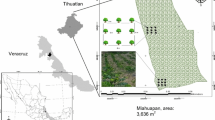Abstract
It has repeatedly been noted that ready availability of well-grown cycad specimens would substantially reduce collection of plants from their natural habitats. Although some cycads are extensively produced in several countries, there is uncertainty as to their optimal growing conditions and fertilizer requirements. UsingZamia floridana (sensu lato) as a model, one-year-old seedlings were grown in 30% and 50% light-exclusion shadehouses for one growing season. They were fertilized with roughly equivalent nutrient proportions of 20-20-20 (N-P-K) Peters solution at 300 ppm applied biweekly, nine-month 18-6-12 controlled-release Osmocote granules, and 16-8-12 Controlled Release Sierra Tablets plus minors at two and three tablets per container, and in combinations. There was interaction between shade and fertilizer types in all parameters measured. Overall, plants grown in 30% shade had a larger caudex, more leaves, and higher leaf and stem-plus-root fresh and dry weights. Peters fertilizer at 300 ppm was least effective in all growth parameters, as compared with other fertilizer treatments. Alone, however, it was more effective in caudex enlargement in 50% shade. No differences were observed between any treatments involving granules, irrespective of supplemental Peters. There was no significant difference between three tablets plus Peters and two tablets only, in 30% and 50% shade. Two tablets plus Peters and three tablets only, however, had a significant effect on caudex enlargement in 30% shade. In 50% shade, three tablets plus Peters or granules alone were more effective. These results and personal experience show that nearly all cycads grow best in ± 30% shade and benefit from fertilizers that contain micronutrients and a higher ammoniacal nitrogen source.
Similar content being viewed by others
Literature Cited
Dehgan, B. 1983. Propagation and growth of cycads: A conservation strategy. Proc. Fla. State Hort. Soc. 96: 137–139.
— 1995. The few, the proud, the cycads. Part I, Morphology and Genera. Amer. Nurseryman 182: 74–87.
— 1996. Permian permanence, the cycads. Part II, Pollination, propagation and cultural requirements. Amer. Nurseryman 183: 66–81.
-. 1999. Propagation and culture of cycads: A practical approach. Pp. 123–131in M. C. Ruano (ed.), Proceedings of the Second International Symposium on Ornamental Palms and other Monocots from the Tropics. Acta Hort. 486.
— &F. C. Almira. 1993. Horticultural practices and conservation of cycads. Pp. 332–338in D. W. Stevenson & K. J. Norstog (eds.), The biology, structure, and systematics of the Cycadales: Proceedings of CYCAD 90, the Second International Conference on Cycad Biology. Palm & Cycad Societies of Australia Cycads, Milton, Queensland, Australia.
— &C. R. Johnson. 1987. Root branching inZamia floridana: Effect of growth regulators and anatomical features. J. Amer. Hort. Soc. 112: 1041–1044.
— &D. McConnell. 1984. Cycads with potential as foliage plants. Foliage Digest 7: 1–3.
—,J. E. Durando &T. H. Yeager. 1994. Symptoms and treatments of manganese deficiency inCycas revoluta Thunb. HortScience 29: 645–648.
Giddy, C. 1996. Cycad Specialist Group: Cycad action plan. Species 26–27: 106–107.
Jones, D. L. 1993. Cycads of the world: Ancient plants in today’s landscape. Smithsonian Institution Press, Washington, DC.
Keever, J. G &G. S. Cobb. 1986. Container production of comptie [sic],Zamia furfuracea Ait. J. Environ. Hort. 4: 89–91.
Osborn, R. 1990. A conservation strategy for the South African cycads. S. Afr. J. Sci. 86: 220–223.
Smith, G. S. 1978. N and K fertilization of Florida coontie,Zamia integrifolia Ait. HortScience 13: 438–439.
Vovides, A. P. 1993. Cycad conservation in Mexico:Dioon edule Lindl., a study case. Pp. 365–369in D. W. Stevenson & K. J. Norstog (eds.), The biology, structure, and systematics of the Cycadales: Proceedings of CYCAD 90, the Second International Conference on Cycad Biology. Palm & Cycad Societies of Australia Cycads, Milton, Queensland, Australia.
Author information
Authors and Affiliations
Rights and permissions
About this article
Cite this article
Dehgan, B., Almira, F.C., Dudeck, A.E. et al. Effects of varying shade and fertilizer on the growth ofZamia floridana A. DC. Bot. Rev 70, 79–85 (2004). https://doi.org/10.1663/0006-8101(2004)070[0079:EOVSAF]2.0.CO;2
Issue Date:
DOI: https://doi.org/10.1663/0006-8101(2004)070[0079:EOVSAF]2.0.CO;2




